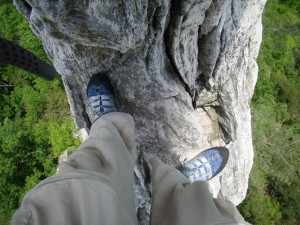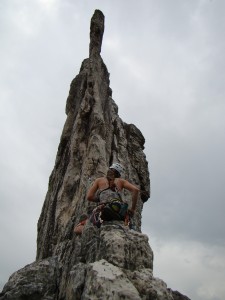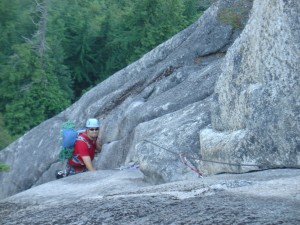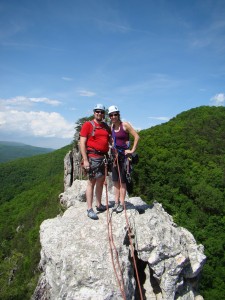Exposure = risk realized, but not increased
Exposure is a commonly used term in rock climbing. I found an online dictionary that defined it as “being in a situation in which you are very aware that you are high off the ground.” In other words, standing on a large summit that is capped by lots of soil and very tall, thick trees would not be considered as exposed as a summit consisting of a 3 foot wide pinnacle several hundred feet off the deck. A steep route traversing across a narrow ridge would be more exposed than a route that meanders up a low-angle slab.
Exposure typically intensifies a route. I have a few climber friends that are afraid of heights (ironic, huh?) and they usually tend to avoid routes that involve a high amount of exposure. In May of 2009, Steve and I went to Seneca Rocks, West Virginia, an area well-renowned for the levels of exposure, even on the easiest of routes, and I feel like I learned a valuable lesson about perspective.
On the second day of our trip, we did a route called “Gunsight to South Peak Direct.” The route goes at 5.4/5.5, which means that as far as climbing routes go, this one was pretty easy. However, this route has been referred to in some circles as “the scariest 5.4 on the planet.” Now, even to beginner climbers, the terms “scary” and “5.4” should not be used in the same sentence. I think it is safe to say that if you can successfully climb a ladder, you should be more than capable to complete the moves on a 5.4 without any sort of difficulty. This route is also given a “G” rating (as opposed to PG-13, R, X), which means that there are plenty of opportunities for the lead climber to place stoppers and camming units into cracks and other features of the rock along the way to keep everyone safe.
So the moves are not complex, no technique required really, and any experienced climber should have no problem with placing the gear – so what makes this route so scary? EXPOSURE. It climbs up a very narrow arete to a summit ridge that is only a few feet wide in places. On either side of you is about 900 feet of air. Even though nothing about the route is difficult physically, you’ve got to flex some mental muscles to keep yourself focused. While I was on the route, I remember thinking that had the physical piece been as intense as the mental aspect, I would have been scared out of my mind!
For the past couple of weeks I have been reflecting on those experiences with exposure, and contemplating just why high exposure situations can be such sobering experiences. Hopefully every climber knows that their sport is one in which certain mistakes are not allowed. If I fail to clip into my anchor or tie my knot correctly, a fall could very likely result in serious injury or death. When I am hanging out at a nice restful stance, feeling secure on low-angle rock that is shielded from the sun and wind by trees, the consequences are the same as being on top of the tiny pinnacle. I know this, and every safe climber will always bear in mind the seriousness of their actions. However, the giant ledge somehow FEELS safer. Even though I can look into the horizon and can tell that I am up quite high, when I look straight down at my feet, I still see dirt. During my weekend at Seneca, more times than not when I looked down to find my next foothold, I saw nothing but air – the exposure brings everything to a new level of awareness – it’s an in your face, stomach-dropping, can’t get it out of my head kind of awareness.
I think this is how life is sometimes. Its easy to get stuck in a rut, going thru the motions on some low-angle slab – feeling safe and secure in the routines of life. Its much more comfortable living there than being vulnerable on the steep, overhanging, “risky” walls. But, in reality, is the slab really that much safer? Are the exposed, steep parts of our lives really that much riskier? How often have you been living in a ho-hum, “safe” mindset one day only to have your world turned upside down the next – a lost job, the death of a loved one, a life-changing injury, etc. This life is a risky undertaking and there is a lot going on under the surface. I’m not saying that we should live in fear of what lies around the next corner – that’s no sort of life at all! I’m just noting that living in ignorance by thinking you are immune from any type of hardship will actually leave you with a false sense of control. Thinking you are “safe” from the storms of life will actually make you less prepared to deal with what life throws your way.
At church a couple of weeks ago our pastor was talking about such storms, and how we shouldn’t necessarily avoid them at all costs, because they can be an opportunity to grow. He said that God leads us into storms for a reason. Even though I don’t always understand the reason, I get that I’m obviously not God, and therefore might not be privy to the Master Plan. But the part that struck me odd was the part about God “leading us into storms.”
At first I thought that seemed a little mean – I mean really, shouldn’t a loving God keep us from the storm rather than plunge us headfirst into it? But the more I thought about it, the more I realized that this is actually quite a comforting picture of God’s love for us. If someone is leading, literally or figuratively, it means that they are going first. God is going thru the storm ahead of us, arranging safe passage for us to make it out on the other side. To me, this is a much more personal idea than the common notion that God is watching from a distance, “allowing” storms to happen in our lives for some cosmic reason unbeknownst to me.
The bottom line is that storms will happen in our lives at one time or another. We could avoid the exposure and take the route that “seems” safer – live life in a bubble, only associating with those who look and think like we do, content wearing glasses of ignorance at what is going on in the world around us, and never let anyone see our weaknesses. Or, we could choose to embrace the exposure – get out of our comfort zones, try something different and new, and perhaps show a little bit of vulnerability and humility.
As the saying goes, “Its a great big world out there.” Living life on the steep side, being exposed and vulnerable to others, isn’t any more dangerous than hanging out on low-angled rock where it feels like there are no risks. Don’t be afraid of the exposure – live your life with your eyes wide open and embrace the rawness of living. 🙂






1 Response to “Exposure = risk realized, but not increased”
Truly when someone doesn’t understand after that its up to other people that they will help, so here it happens.